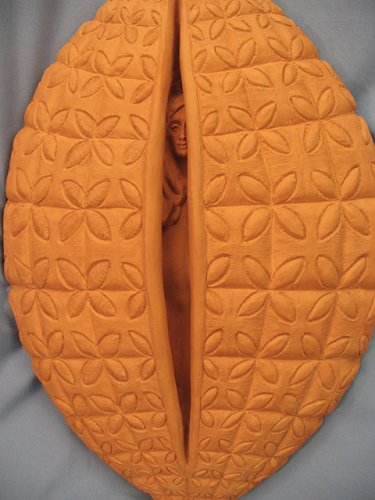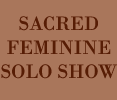

|
|
 |
About the Piece I started Mandorla Egg with Almond Cross Pattern in November of 2004 and finished it August of 2005. Here is an entry from my diary that discusses some of the ideas that went into this piece:
“A lot has happen since my last entry. The biggest change has been no change; George Bush still usurps the White House. The two weeks before the election I went all out for Kerry. I stood at the corner of the Boulevard of the Allies and Halket Street, Penn Circle, and Aiken Avenue and Center Avenue waving signs and dancing around with my sign for Kerry. I spent evenings making phone calls from the Move On and Victory 04 headquarters. Three days before the election I canvassed countless homes and spent Election Day working at the polls. The few days after the election were a fog of disbelief, then dread and depression set in for me. I started a new piece of a large yoni with the almond cross pattern all over it. There is a large slit running the length of the piece. Deep within this crevice I have placed a woman. Who is she? I don’t really know. Perhaps she is the spirit of the yoni. Is she trapped in there waiting to come out? Is she hiding? Is she emerging, or retreating? Part of my mission as an artist is to make utopian art, art that provides hope and envisions solutions to our confusion and pain. Great Mother I certainly have been in pain over the election. While making the piece at times the women in the yoni looked like she had retreated into her shell, to hide and peak out until she knew it was safe to come out. Other times she seemed to be trapped, as if the shell around her was enveloping her and she was suffocating inside of it. However, I will not make a negative piece, which continues to affirm a world of victimization, but I must admit to my self that at times the piece was going in a direction I don’t want. I will continue to work with the piece until it looks as if the woman belongs in the yoni, that she will emerge, or that we have peeked into the yoni to see the spirit of the yoni that resides deep inside.”
“The head of this key was not the traditional long-stemmed Christian cross but rather was a square cross—with four arms of equal length—which predated Christianity by fifteen hundred years. This kind of cross carried none of the Christian connotations of crucifixion associated with the longer-stemmed Latin Cross, originated by Romans as a torture device. Langdon was always surprised how few Christians who gazed upon “the crucifix” realized their symbol’s violent history was reflected in its very name: “cross” and “crucifix” came from the Latin verb cruciare—to torture.” …equal-armed crosses like this one are considered peaceful crosses. Their square configurations make them impractical for use in crucifixion, and their balanced vertical and horizontal elements convey a natural union of male and female…” (p. 145).
In the descriptions by Brown, Walker and Jung, the cross, a predominately male symbol, is described. Yet, the area surrounding the cross is regarded as the background, or the negative space, which serves to highlight the positive subject: the cross. This relationship between the cross and the surrounding space can be seen as a metaphor to describe the relationship between men and woman. Women have been cast as the background, the negative space, the invisible, the secondary, the discarded. Seeing the “invisible spaces” between the arms of the cross was an ah-ha experience for me. I had just finished Dan Brown’s The Da Vinci Code in March of 2004 and was sketching the templers cross in my art journal, when in a lighting flash, instead of seeing the cross, I saw nestled between the arms of the cross, four yonis! I was overjoyed to see how these two powerful symbols, the cross and the yonis, defined each other and were dependent upon each other to shape the others form. Therefore, I have modified the Templars cross, and have taken it in a different direction by highlighting the spaces between the arms of the cross: the yoni’s. Although my version of the cross is similar to the Templar’s cross, it is not one I have seen before. From here on in I will refer to this symbol as the Almond Cross, a name I have devised that acknowledges both the male and female forms. “Mandorla means “almond,” which was one of the more cryptic synonyms for this symbol, also known as vesica piscis, the Vessel of the Fish, and more simply as the yoni. Almonds are female-genital symbols and maternity charms from very ancient times. The virgin birth of the god Attis was conceived by a magic almond. Even the Israelites’ tabernacle made use of its fertility mana (Exodus 37:20), and Aaron’s rod produced almonds in token of a general power of fructification (Numbers 17:8).” (Walker, 1998, pg. 10). The mandorla shape found in the the Almond Cross is repeated in the over all shape of the piece itself.
For questions or comments about Cydra's art, please email: womansculpture@icloud.com |

